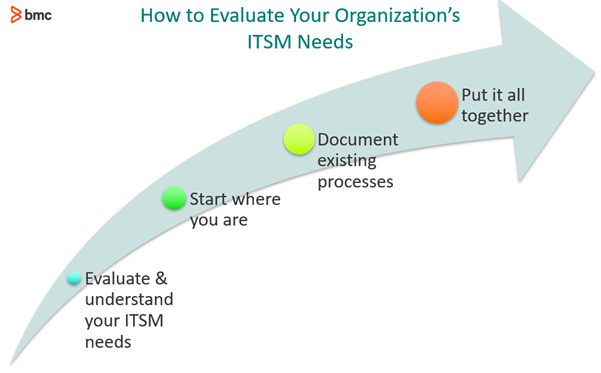One question I am often asked as an ITSM consultant is, “Where do we start with IT service management?” My answer is that you don’t start with ITSM. Instead, you start by looking at the business outcomes you are trying to achieve, then you work back to understand which ITSM practices will help achieve those outcomes.
Another answer is that you’ve likely already started, regardless of whether your organization has deliberately adopted a specific ITSM framework, such as ITIL®. I guarantee that you are using service management practices currently—you simply may not realize this is what you’re doing. The chance that you are starting in a total greenfield for ITSM is very remote, unless you are a start-up that has not yet opened the doors or turned on a single computer.
When evaluating your company’s ITSM needs, start with these four steps.

1. Evaluate and understand your ITSM needs
Step one should be obvious but, sadly and quite bewildering to me, it is often neglected. That step is simply to go out to your business and find out what you and other stakeholders expect to achieve from your ITSM initiatives. Make no plans until this has been done. If you do not understand the business outcomes you’re trying to achieve, then you are flying blind and simply imposing your own preconceptions on your organization.
In many organizations, ITSM, and more specifically ITIL, have a very poor reputation. In nearly every case this is because IT has tried to impose its own ideas on the business and built their ITSM practices around their own wants and desires, rather than taking the time to understand what the business wants to achieve.
Once you have met with the business and documented required outcomes, you can then define what the outputs from your ITSM practices must be in order to meet those objectives. Business outcomes will normally be expressed in terms of profit, customer retention, and growth. Examples of desired business outcomes include:
- Increased profit
- Increased customer satisfaction
- Growth in customer base
- Reduction in IT-related costs
These outcomes should focus on getting the organization closer to achieving the company’s vision. With these outcomes established, you can then look at how outputs from ITSM practices can help to move the organization closer to achieving these. Your ITSM outputs might look like this:
- Stable IT infrastructure
- Reliable customer online services
- Minimal business hours outages
- Fast response time to major incidents
- Adherence to agreed SLA times
The ability to deliver these outputs relies on inputs from your ITSM practices, so only now can you begin to consider the question “Where do we start?”
2. Start where you are
Next, I give you another simple answer, straight from the ITIL 4 guiding principles: Start where you are.
It is highly unlikely that you are starting from ground zero. Even if your organization has not officially adopted any type of service management framework or implemented a help desk or service desk solution, you still have some way of managing IT outages or queries. It may not be perfect, it may not even be vaguely efficient, but it will provide you with a starting point that you can improve on. Looking at the outputs identified above gives a clear roadmap to the ITSM practices that could be developed to help achieve these.
3. Document existing processes
A stable IT infrastructure is, to a large extent, driven by effective change management practices, so this would be my first stop in this journey. Look at current processes—are these documented and followed? If processes are not clearly defined, start by documenting how change is currently managed.
Once you understand your current situation, look at which parts of the process are working and which are not. Visualize your desired end state, then plan the improvement journey that will fill the gaps between current and future states.
Keys to success in this stage include:
- Making small, incremental improvements
- Assess these improvements
- Gathering feedback on these improvements
- Adjusting as needed
- Taking the next step towards next-priority improvements
In this way, you’ll build a practice that works for your organization and delivers against business requirements.
4. Put it all together
Delivering high-availability online services to your customers relies on multiple practices—availability, capacity, and demand management will be key players, along with your incident management practice. The advice remains the same: start with where you are, understand what you are doing well, improve incrementally, and seek feedback after every iteration.
In this example, I would recommend the organization concentrate on the following practices, in order to meet business needs:
- Incident management
- Change management
- Availability management
- Capacity management
- Demand management
- Major incident management
- Problem management
- Knowledge management
As with any example, this is educational only. Every organization must examine its own processes against its own business goals. Each company has a unique vision, level of maturity, and custom needs (and approaches) for service management. There is no ‘one size fits all’ in ITSM. Understand your business and start where you are—these are the critical pieces of advice I would like you to take from this article.
These postings are my own and do not necessarily represent BMC's position, strategies, or opinion.
See an error or have a suggestion? Please let us know by emailing blogs@bmc.com.






